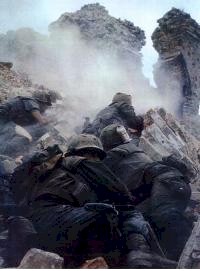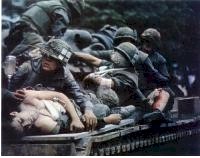
Battle Of Hue City
The city of Hue, South Vietnam, was the site of one of the fiercest battles of the Vietnam War. Three understrength U.S. Marine battalions, consisting of fewer than 2,500 men, attacked and soundly defeated more than 10,000 entrenched enemy troops, liberating Hue for South Vietnam. Situated in central Vietnam, Hue was the country’s
cultural capital, a unique blend of French and Vietnamese influence. The Imperial City, it
gracefully retained the glory of Vietnam’s past while its universities educated
Vietnam’s brightest minds for the future. Hue was a symbol of everything the
Vietnamese people admired and respected. For this reason, it was spared the terrible
effects of war—until Tet 1968.
Situated in central Vietnam, Hue was the country’s
cultural capital, a unique blend of French and Vietnamese influence. The Imperial City, it
gracefully retained the glory of Vietnam’s past while its universities educated
Vietnam’s brightest minds for the future. Hue was a symbol of everything the
Vietnamese people admired and respected. For this reason, it was spared the terrible
effects of war—until Tet 1968. North Vietnamese and Viet Cong forces were driven out of Hue
little by little as U.S. Marines retook the city one block at a time. The Marines retook
the Treasury building, the university, the hospital, the Provincial Headquarters and,
finally, the citadel. On February 26, 1968, the city of Hue was declared secure. U.S.
forces remained another week to ensure the city’s safety.
North Vietnamese and Viet Cong forces were driven out of Hue
little by little as U.S. Marines retook the city one block at a time. The Marines retook
the Treasury building, the university, the hospital, the Provincial Headquarters and,
finally, the citadel. On February 26, 1968, the city of Hue was declared secure. U.S.
forces remained another week to ensure the city’s safety.Vietnam Veterans Home Page
2nd Battalion 5th Marines Home Page
Battle of Hue Bibliography
Bullington, James R. "And Here, See Hue," Foreign
Service Journal,
November 1968.
Christmas, G. R. "A Company Commander Reflects on Operation Hue City,"
Marine Corps Gazette, April 1971.
_______. "A Company Commander Remembers the Battle for Hue,"
Marine Corps Gazette, February 1977.
Davidson, Phillip B. Vietnam at War: The History, 1946-1975. Novato, CA:
Presidio Press, 1988.
_______. Secrets of the Vietnam War. Novato, CA: Presidio Press, 1990.
Hammel, Eric. Fire in the Streets: The Battle for Hue, Tet 1968.
Chicago: Contemporary Books, 1991.
Harkanson, John, and Charles McMahon. "USMC & Tet ’68: There’s a
Little Trouble in Hue …," Vietnam Combat,
Winter 1985.
_______. "Tet ’68/USMC in Hue: The Grunts’ War," Vietnam Combat,
Spring 1986.
_______. "Tet ’68/USMC in Hue: The Second Week," Vietnam Combat,
Summer 1986.
_______. "The Last Days of Tet ’68: Hard, Hungry, Horrible,"
Vietnam Combat, Winter 1986.
Nolan, Keith William. Battle for Hue: Tet 1968. Novato, CA: Presidio
Press, 1983.
Oberdorfer, Don. Tet!: The Turning Point in the Vietnam War.
New York: Doubleday & Company, 1971.
Palmer, Dave Richard. Summons of the Trumpet: U.S.-Vietnam
in Perspective. Novato, CA: Presidio Press, 1978.
Phan Van Son. The Viet Cong Tet Offensive (1968). Saigon:
Republic of Vietnam Armed Forces, 1969.
Pike, Douglas. PAVN: People’s Army of Vietnam. Novato, CA:
Presidio Press, 1986.
Smith, Captain George W., USA. "The Battle of Hue," Infantry,
July-August 1968.
Stanton, Shelby L. Anatomy of a Division: 1st Cav in Vietnam.
Novato, CA: Presidio Press, 1987.
_______. Vietnam Order of Battle. New York: U.S. News and
World Report, Inc., 1981.
Tolson, Major General John J., 3rd. Airmobility: 1961-1971.
Washington, D.C.: Department of the Army, 1973.
Truong Sinh. "The Fight to Liberate the City of Hue During Mau Than
Tet (1969)," Hoc Tap, December 1974.
Westmoreland, General William C. A Soldier Reports. Garden City, NY:
Doubleday & Company, 1976.
